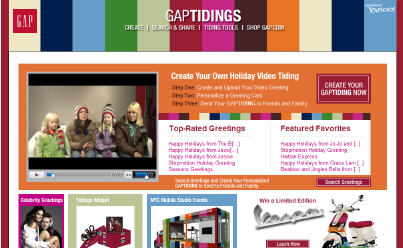-
UGC and Brand Marketing, Part 2
Wrapping up the week, today I revisit a post from several weeks ago, "An Intersection of UGC and Brand Marketing?"
In that post I mused about the opportunity for brand marketers to harness the recent enthusiasm many consumers have for creating video, as evidenced by the popularity of sites like YouTube. The idea I floated concerned how brands might somehow incent consumers to produce informative videos about their favorite products, which in turn could be showcased by the brands to help prospective buyers were in research mode. It seemed to me there might be a happy marriage in there somewhere.
It turns out I may have had my head in the clouds on this one. Daphne Kwon, CEO of ExpoTV reached out to me to explain some of the realities that my idea would encounter. Daphne's in a good position to know, since ExpoTV runs a site offering users the opportunity to upload videos with their reviews/opinions about products. ExpoTV has aggregated over 200K of these "Videopinions" to date. ExpoTV isn't exactly the concept I had in mind to marry UGC and brands, but it's definitely in the same ballpark.
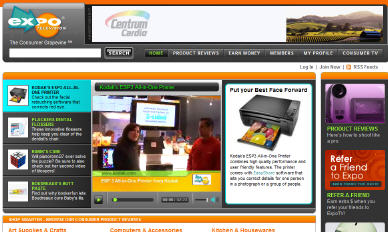
Daphne raised two issues which she believes constrains brands from pursuing the user-generated reviews idea I envision. First is the specter that these reviews will be biased in some way. There are multiple dimensions to this. Will the brand maintain a completely open environment so that even negative reviews would be posted? If so, what are the implications? If not, and only positive videos are exposed, then the area wouldn't feel authentic or trustworthy. Also, would reviewers bias toward saying positive things simply to ingratiate themselves with the brand for ulterior reasons, such as getting noticed to be in a future ad or obtain funding for a private project?
Further complicating this is Daphne's sense that when people upload videos they're doing so to be part of a community that is responsive and interactive. This has clearly been a big part of YouTube's success. So brands couldn't just offer a place to upload, but rather would need to hire staff to manage the area, interact with participants, figure out how the area should be policed or self-policed, etc. Daphne doesn't see brands biting all off all of this, as it's a lot of work and she doesn't see any corporate mandates for brands to actively participate in these kinds of community-building activities.
Second and possibly more problematic is that there may be legal liability for brands to provide such platform, as the brands might be held responsible for the truthfulness and accuracy of the user-submitted videos. This liability would be broad, ranging from the relatively small (e.g. "The product didn't work as explained") to the very significant (e.g. "I used the product this way and was injured."). Clearly, in the litigious society in which we live, deep-pocketed corporations could be exposing themselves to all kinds of financial risks. Then of course there is the risk of negative PR, which alone could be quite damaging. Tying back to issues above, if there isn't a clear mandate to pursue these activities, no astute corporate soldier is going to risk his/her career diving into such precarious waters.
Hearing these considerations makes me think that the optimal route for incenting user-created video reviews may just be the way ExpoTV is doing it. Provide a "well-lit" space with a mix of financial incentives and community recognition, and monetize traffic in a number of creative ways (affiliate deals, advertising, etc.). Importantly maintain a focus on the community-building tasks required for motivating active and continuous user participation.
All of this serves as another reminder that with broadband - as with technology in general - just because something is possible, doesn't necessarily make it advisable.
What do you think? Post a comment and let us all know!
Categories: Brand Marketing, UGC
Topics: ExpoTV
-
Three Broadband Video Themes from February `08
At the end of each month I plan to step back and recap a few key themes from recent VideoNuze posts. Here are three from February '08:
Brand marketers embrace broadband video
One clear theme from the past 4 weeks has been brand marketers' accelerating moves into the broadband video space. This was on full display by select Super Bowl and Oscar advertisers. We are witnessing an unprecedented commitment by brands to create their own entertainment/information video content and also to induce consumers to create brand-related video through user-generated contests. As I detailed in yesterday's webinar, examples in the former category include Kraft/Tassimo, J&J, CIT Financial and GoDaddy.com, while examples in the latter category include TideToGo/MyTalkingStain.com, Heinz/Top This, Dove Cream Oil Body Wash and T-Mobile/Current TV.
Through VideoNuze I track all brands' broadband video initiatives, and it is clear that their involvement in this new medium is intensifying. Faced with splintering audiences, ad-skipping DVRs and changing media consumption habits - particularly by younger demos - brands have no choice but to get into broadband video. This results in an entirely different awareness/engagement paradigm than we're accustomed to from the world of interruptive TV advertising. Brands today increasingly recognize that a key way to create loyalty (and generate sales!) is by engaging the audience on its terms, using broadband and other technologies to accomplish this.
Monetization is the #1 challenge
Another key theme of the past month was the ongoing quest for broadband video monetization. As I also mentioned in yesterday's webinar, this is the number 1 business challenge for all broadband video industry participants - both content and technology providers. Two companies I wrote about this month, EveryZing and Veveo, are focused on improving content discovery, which leads to more consumption and revenue-generating opportunities. I also wrote about Jake Sasseville, a young entertainer who is pioneering multi-platform initiatives to forge a new revenue model.
Innovation is key in this space. Next week I'll be writing about Freewheel, an innovative startup that's just surfaced, which is providing a new approach to managing broadband video advertising. And yesterday, Magnify.net, one of my favorite early-stage companies, which focuses on enabling video content distribution, announced that it has raised an additional $1 of financing.
In addition, the big dogs of the technology and media landscape are in hot pursuit of improved video monetization as well. This month alone brought news of Yahoo's acquisition of Maven Networks, an ad-centric video platform, Google's beta rollout of AdSense for video, and the hostile bid by Microsoft for Yahoo, a deal that has vast longer-term implications for online and broadband video advertising. In short, monetization is a key focus for all large and small industry participants - cracking this nut is crucial to the long-term health of the industry.
Net neutrality re-surfaces
Lastly, this month also brought a lot of news on the regulatory front. Twice I wrote about "net neutrality," a regulatory concept its proponents believe will keep the Internet free from discrimination by broadband ISPs. While I don't agree with their viewpoint, what is clearly true is that net neutrality is being spurred by the massive adoption of broadband video, which places an unprecedented load on broadband ISPs' networks.
So that's it for this leap year month. Three themes you'll be hearing much more about going forward: brand marketers' broadband video initiatives, video monetization and net neutrality. See you on Monday for the start of a new month!
Categories: Advertising, Brand Marketing, Broadband ISPs, Regulation
Topics: EveryZing, FreeWheel, Google, Magnify.net, Maven Networks, Microsoft, Net Neutrality, Veveo, Yahoo
-
And the Oscar Goes To.....Dove
Obviously there is no Oscar category for "Most Effective Advertisement at Oscar.com," but if there were, the hands-down winner last night would have been Unilever's "Dove Supreme Cream Oil Body Wash Ad Contest" display ads.

As many of you know, I'm a big believer that brand advertisers need to evolve their mindsets, which have traditionally called for making the cutest or the funniest or the quirkiest ad and then spending big money on placing it on popular programs, in the hopes of driving audience awareness and recall.
Instead, advertisers need to be focusing on user engagement, reinforcing brand authenticity, leveraging multiple platforms and extending the campaign's life. Dove did all of these and more with its "Cream Oil" campaign, and the resulting lessons for other brand marketers and their agencies are abundant.
Dove kicked the "Cream Oil" campaign off late last year, with a user-generated video contest asking women "how does showering yourself in everyday luxury with Dove Supreme Cream Oil Body Wash make you feel?" There were 3,500 entries received for the 30 second spot between Dec. 5th and Jan. 9th, which were winnowed to 5 semi-finalists on Jan 30th who were invited to LA for a private Oscars party. The 2 finalists were presented for viewing on Oscar.com. Dove's display ads on the site prompted visitors to click and vote for the best spot, which would become Dove's new ad. This voting process created an even larger user engagement opportunity than the original UGC contest. Capping it all off was actress Amy Brenneman, announcing the winning ad during a spot Dove bought during the Oscar telecast.
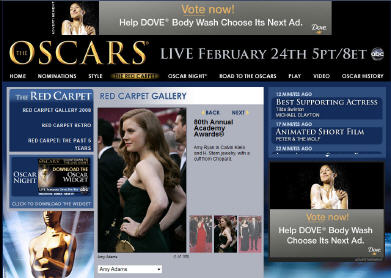
In my post last week, "An Intersection of UGC and Brand Marketing?" I proposed that brand marketers should create opportunities for passionate customers interested in expressing themselves to submit user-generated video supporting or explaining products. Dove's marketing people were clearly in synch with this thinking. The campaign shows their belief that the authenticity of the Cream Oil product could best be conveyed by real women using video to creatively express themselves. That sense of authenticity in turn resonates really well with other prospective customers. The YouTube age has conditioned many of us to appreciate each other's video more than the professionally produced, because its rough edges make it feel far more real.
Lastly, by having Ms. Brenneman announcing the winner in the on-air spot, Dove recognized that if it is going to spend $1.7 million + for a 30 second ad (last year's price), it better do more than just offer another cute, funny, or quirky spot. Instead it created anticipation, and capped off 3 months of contest excitement. I've argued in the past that these expensive on-air spots should reinforce or continue campaigns begun before and/or extended after in the broadband medium. Doing so increases their ROI, and will only raise the value of this on-air time in the future.
In the past I've been critical of brand marketers and their agencies for being abysmally slow in recognizing new opportunities broadband video presents. Yet there have been exceptions, and Dove's "Cream Oil" campaign is certainly one. Hopefully we'll see more like it in the future.
What do you think? Post a comment and let us all know!
Categories: Brand Marketing, UGC
-
Staying in Synch with Broadband Users
Yesterday's interview with market researcher Bruce Leichtman highlighted a key point in his latest study: that broadband video is most heavily adopted by 18-34 year old males. That point has been supported by research from other firms and is one of the key drivers behind a lot of the new broadband-only video programming that's sprouted up in the past couple of years.
A clear implication of this finding is that current video providers that target 18-34 males better be aggressively pursuing broadband video offerings if they want to stay competitive in this new media landscape.
But less clear is whether video providers that don't primarily target 18-34 males, or maybe have them as secondary audiences, should also be investing in this new medium in order to stay in synch with broadband users. Though other age groups and demos are also adopting broadband video, they are clearly less fervent, at least for now. In a world with finite resources, should these other video producers not worry so much about broadband video and instead stay mainly focused on their traditional approaches? Or should they invest in the broadband medium as well, even if their true target audiences may be smaller for now? I think they should do the latter, for the following 3 reasons:
1. Eventually broadband video usage will deeply penetrate all age groups. This is a macro trend that all programmers need to be in synch with. Previous technology adoption patterns show that what starts with young, and often male, early adopters, eventually spreads out to other groups as well. There's no putting the broadband video genie back in the bottle. Three-to-five years from now, virtually all Internet users will view video as just another routine application, alongside email, search, commerce, etc. Today's video providers need to position themselves properly.
2. Cultivating younger audiences is critically important. Marketing types always emphasize how important it is to cultivate younger audiences. Brand choices and loyalties are developed early, and it is more difficult down the road to influence these. Look around and see brands that once targeted somewhat older, and wealthier, segments but which now also try to target the young - Heineken, BMW and Tiffany to name a few.
The fact is that young people have energy, enthusiasm, spending power and a strong desire to promote their favorite brands to cohorts. So even video providers need that may not normally skew young need to figure out how to have some appeal to this group, because they will be key drivers of the brand's strength down the road. In fact this is what a number of cable networks, like Lifetime, AMC and Food Network been doing in recent years. Though they didn't originally target younger audiences, they began cultivating them through programming choices and marketing campaigns. They are all succeeding.
3. Now is the time to learn about broadband video. Given the above two reasons, it is urgent that video producers targeting all age groups and demos start their learning process now. Finding pockets of current heavy users to appeal to is the key challenge. As a new medium, broadband has its own set of capabilities well beyond being just another pipe to funnel current programming. Understanding these opportunities will not happen overnight. No video producer should wake up one day 3 years from now, when a healthy percentage of its viewers are spending substantial time on broadband, and realize they didn't cultivate the knowledge and skill sets to succeed in this new medium.
Video producers across the spectrum are grappling with how to attract and retain audiences in the broadband and on-demand era. Though 18-34 year old males are today's heaviest users, that will change over time. All video providers need to stay in synch with this.
What do you think? Post a comment and let us all know!
Categories: Brand Marketing, Strategy
Topics: AMC, BMW, Food Network, Heineken, Inc., Leichtman Research Group, Lifetime, Tiffany
-
An Intersection of UGC and Brand Marketing?
(Quick correction - there was a technical problem with the link in yesterday's email to register for the Feb. 28th webinar. The correct link to register is here).
Lately I've been thinking a lot about where there may be potential points of intersection between user-generated video and brand marketing.
On the one hand, YouTube and others have demonstrated there's huge interest among amateur producers in creating and posting video content. Since the overwhelming majority of these producers do not make any meaningful money from these videos, their motivation is emotional. On the other hand, brands are grappling with things like how to break through the clutter, deepen consumer engagement, create more authenticity and build loyalty.
So it seems like there should be a natural point of intersection if brands could incent their passionate customers to create videos which not only sang the praises of their favorite products but actually provided valuable information sought by other prospective customers. Offering these videos would enable customers to show off their favorite products in action and also provide a valuable service to prospects. The concept is sort of like a video-based TripAdvisor, but not limited to travel.
Here's an example from a personal experience. Recently I've been in the market for a 50+ inch HDTV. If you've been in this mode recently you know the drill - lots of online research, reading users' comments, going to stores to see different models, etc. Even after doing all this, I still felt like I was missing something. I really wanted to see the intangibles - what distance seemed right, what's the right height for the stand, what were the ambient issues, how were accessories connected and so on.
In short, I was looking for actual owners to provide short, but informative videos showcasing how the TV actually worked out when brought into their homes. To be sure, there's no shortage of text comments to this effect. But the best I could find beyond text was a link at Amazon to "Share your own customer images." It seems like such a natural to me that online retailers, review sites and TV manufacturers should all provide a user-generated video platform for consumers to upload videos providing further information on their TVs.
What I'm describing is not another brand-sponsored UGC contest, but rather solid consumer-contributed product information. T-Mobile has something like this running with Current TV right now, but seems to really be the exception. I looked at the web sites of Sony, Samsung, Panasonic, Sharp, Philips and Mitsubishi and, although in some cases there are buying guides and FAQs, none of them seek to harness the enthusiasm of their actual customers by enabling video contributions.
Maybe I'm missing something, but I think this is a big untapped opportunity. I know companies like ViTrue and StashCast are pursuing opportunities like this, and then there are countless private label social network platforms like KickApps, Ning and others (TechCrunch has a good list here) that also enable some flavor of this. But I just haven't seen this concept clearly or pervasively implemented yet. If you have, please post a comment. I just have to believe that some smart brands - particularly those selling complex, expensive products that benefit from video-based information - are going to realize their passionate customers are incredible assets just waiting to be empowered to speak out through user-generated video.
Categories: Brand Marketing, UGC
Topics: Amazon, Current TV, KickApps, Ning, Stashcast, T-Mobile, ViTrue
-
Last Super Bowl Post - I Promise
I promise, this will be my last post on the Super Bowl ads. I suspect some of you are getting sick of hearing about them, but the reality is that there are some cool follow up tidbits emerging that I think many of you will be interested in.

First a clarification. I accidently omitted mentioning Audi as another Super Bowl advertiser that had a broadband component to their ad. Their mention of "TruthInEngineering" at the end of their spot was so quick that I didn't even notice it. That's a shame, because when you visit the mini-site there's a lot of great video, including one lasting 3 minutes all about the making of the ad.
Ken Liebeskind has a good interview with Paul Venables, who is the founder and co-creative director of the ad agency that created the spot and the videos at the mini-site. I really like how well developed the whole "Truth In" concept has been executed in the mini-site. My only gripe with the execution of the TV spot is that just flashing "Truthinengineering.com" at the end for a quick second is insufficient to really optimize traffic flow. Though Venables says traffic is way up since the game, I think it would be far higher had they focused on the URL longer.
Meanwhile, some interesting follow up stats that have bubbled up. comScore is reporting that 13% of Super Bowl viewers watched an ad online and that 13% visited an advertiser's web site. Of those who visited an advertiser's web site, 38% visited GoDaddy.com, 22% Coca-Cola and 21% Pepsi.
YouTube's AdBlitz Gallery provides the number of views for all the ads. The top 5 list is currently: SoBe LifeWater/Thrillicious (740,094),
Derek Jeter/G2 (677,686), Bridgestone/Scream (564,986), ETrade/Talking Baby (530,397) and CareerBuilder/Queen of Hearts (442,273).Lastly, the Cincinnati Enquirer is reporting that MyTalkingStain.com, the mini-site TideToGo promoted, had received 30,000 visits by the end of Sun night and already had 5,500 customized ads created. The UGC contest at the site invites users to create their own spoof of the Super Bowl ad. In my opinion, Tide To Go gets top honors for making all the right moves: A clever game spot. Great promotion to the mini-site. Great engagement opportunities and payoffs for consumers. I think it's a model for future Super Bowl advertisers to follow.
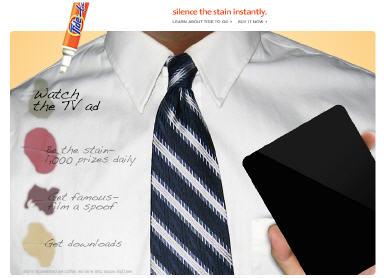
Ok, that's it. Now I'll shut up about Super Bowl ads, until 2009.
Categories: Brand Marketing, Sports
Topics: Bridgestone, CareerBuilder, Coca-Cola, ETrade, G2, GoDaddy, Pepsi, SoBe LifeWater, YouTube
-
A Little More Super Bowl Fun
OK, today no rant, just one more little insight to offer from Super Bowl ads.
Yesterday I highlighted the 5 ads (out of the total 52) which had a broadband component. They were:
GoDaddy - promoting Danica Patrick's "Exposure" banned ad and other videos
TideToGo - promoting "MyTalkingStain.com" a fun microsite
SoBe LifeWater - promoting "Thrillicious.com" a microsite where 2 more spots with the dancing lizards can be seen
Sunsilk - promoting "LifeCantWait.com", a microsite with a UGC contest which is not yet active
Pepsi - promoting "PepsiStuff.com", where users can download videos and music
I'm able to track click-throughs to each link I share in these emails. I thought you might be interested to see a graph of these clicks from yesterday. Note they're shown as an index, not actual numbers, with a starting index value of 100 for Sunsilk.
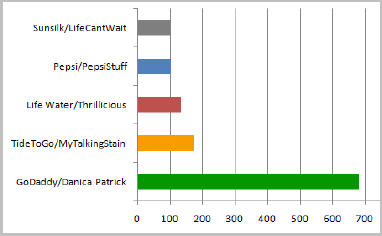
As you can see, VideoNuze email recipients expressed a pretty strong interest in the GoDaddy.com Danica Patrick ad. I'm sure many of you are not surprised since it has a pretty overt potential payoff for visitors.
Though the specifics of that payoff (is Danica actually going to remove her jacket and expose herself?) are very enticing, I think the larger issue to pay attention to is: how can advertisers explicitly use suspense, uncertainty and payoff to drive audiences to do something? Here's the last frame of the Danica spot:
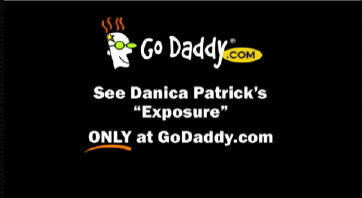
To make this more tangible, consider this: The SoBe LifeWater ad was easily the most impressive use of special effects of all the Super Bowl ads. No doubt the SoBe LifeWater folks spent heavily making the ad, and then paying supermodel Naomi Campbell to dance with the pack of lizards to Michael Jackson's "Thriller." It certainly qualifies as the kind of thing that people would be interested in seeing more of, had SoBe LifeWater teased fans the right way at the end of the ad.
But they didn't. Instead, they simply flashed the URL "Thrillicios.com" at the end of the spot. Nothing was said about what to expect there, why you should go there, what surprises were in store, etc. (In fact there are 2 very funny and clever "episodes". And by the way, does this imply a new Life Water iguana series? Who knows?). Here's the last frame of the SoBe spot:
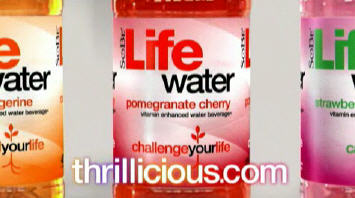
The point is this: I think SoBe LifeWater missed a huge opportunity to keep viewers engaged, which would have both improved the ROI on their Super Bowl ad spend, and also deepened viewers' engagement with the brand. While the Campbell spot was hugely entertaining, it did little to power ongoing engagement. Contrast this with GoDaddy, which no doubt had people pouring into its web site since the spot ran, with ongoing chatter and brand-building taking place.
As I said yesterday, advertisers need to understand how to use broadband video to evolve Super Bowl ads from having big-time entertainment value to having big-time engagement value. Some like GoDaddy get this, while many others, like SoBe LifeWater, are still on the learning curve.
What do you think? Post a comment and let us know!Addendum - I missed this piece in AdAge "GoDaddy Super Bowl Spot Sets Web-Traffic Record." The "Exposure" on-air ad drove 2 million visits to the site, during the game alone, a record for GoDaddy since it began advertising on the Super Bowl. And no doubt a multiple of that since the game ended. More evidence that GoDaddy nailed it big-time.Categories: Brand Marketing, Sports
Topics: GoDaddy, Life Water, Pepsi, Sunsilk, Super Bowl, TideToGo
-
More Nuze on Branded Entertainment
Hey, maybe I should go into scripted programming...no sooner did I post "Branded Entertainment is Upon Us" this morning, than AdAge is running "Dorm-Life Opens Doors to Initiative."
The piece is all about how Initiative Media has partnered with the webisode's producer, Attention Span Media to do secure sponsor tie-ins. Initiative sports clients such as Carl's Jr, Cadbury-Schweppes and Victoria's Secret, all of whom are no doubt eager to reach the program's target audience.
Echoing the theme of my post, and Shelly Lazarus's presentation at NATPE yesterday, AdAge quotes Jon Haber, director of Initiative Media's innovations department as follows: "...for your advertising to be noticed, your advertising has to be content."
Yes, the age of branded entertainment is clearly upon us.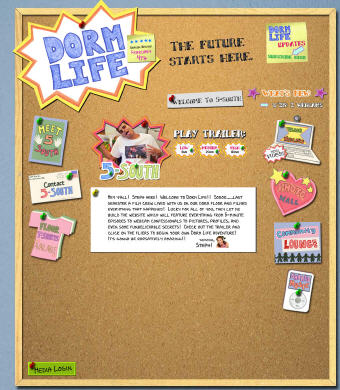
Categories: Brand Marketing
Topics: Attention Span Media, Initiative Media
-
Branded Entertainment is Upon Us
If you had any doubts that brand marketing and entertainment programming are converging, an hour spent
 listening to a presentation at the NATPE conference yesterday by Shelly Lazarus, Chairman and CEO of Oglivy & Mather Worldwide would have quashed them in a hurry.
listening to a presentation at the NATPE conference yesterday by Shelly Lazarus, Chairman and CEO of Oglivy & Mather Worldwide would have quashed them in a hurry. This new reality is a direct result of the audience-fractured, advertising-averse world in which we now live. Ms. Lazarus believes that for agencies, "the challenge as stewards of brands is to help them tell a better story." In fact, telling a better story (the traditional agency imperative, I would argue) is no longer sufficient, as Ms. Lazarus continued: "Now brands need to be a part of the content story."
As such, she envisions far tighter links between ad agencies and the Hollywood creative community. Drawing a meaningful distinction about these industries' respective roles, she explained to the audience of content types: "We need all of you desperately...we can come up with a brand idea, but we can't do programming."

She emphasized repeatedly that to optimize the branded entertainment relationship, agencies and the advertisers they represent should not be called upon to "write a check" when production is virtually wrapped up. Rather, they should be brought in as early in the creative process as possible, and be provided an opportunity to help shape the story narrative and become a vital part of it.
Even while recognizing the role that brands have played since the early TV days of sponsored "soap operas", this proposed tight intertwining of advertising and programming will no doubt strike creative purists as heretical, while sending consumer protection advocates to DEFCON 5.
Regardless, the branded entertainment initiatives Oglivy is now encouraging its clients to selectively pursue reflects nothing more than the hard realities of today's complex and brutally competitive marketplace. Empowered by ever-stronger technologies - broadband chief among them - consumers are getting choosier in their media consumption habits, with advertisers and their messages getting the short end of the stick. With technology increasingly defining young people's lifestyles, this is a trend that will only intensify.
Faced with this daunting prospect, leaders in the agency world like Ms. Lazarus have astutely recognized that by carefully placing their clients' brands within the story line itself, they are creating a much-needed firewall, not to mention a breakthrough new consumer engagement opportunity. To be sure, branded entertainment is not a willy-nilly pursuit, at least not at Oglivy. The agency has set up a unit solely to create, execute and manage these opportunities. Listening to Ms. Lazarus, it was apparent that for all her enthusiasm for branded entertainment, she knows it's neither universally appropriate for all brands nor a catch-all cure to all that ails the industry.
Branded entertainment and broadband video are a perfect match in many respects. Broadband video's nascent development, combined with its still unclear monetization mechanisms and flexible/interactive capabilities make it fertile ground for agencies such as Oglivy to experiment.
So where specifically does all this lead? Three things I would bet on: more product-centric viral video initiatives like Dove's Evolution (presenting an opportunity for Dove - an Oglivy client - to "have a point of view about beauty," as Ms. Lazarus put it), more product sponsored and conceived programming (e.g. Hellmann's "In Search of Real Food" on Yahoo; Hellman's is another Oglivy client) and more user-generated video contests around products (e.g. Frito-Lay, Heinz, etc.).
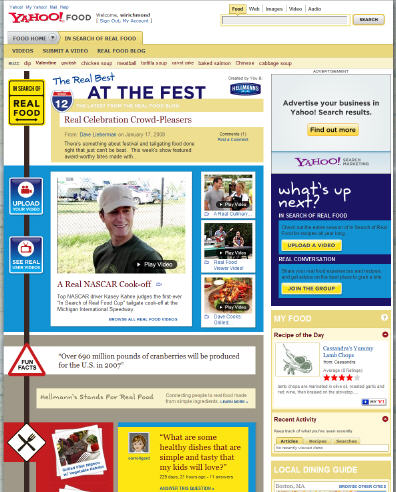
Broadband video is flowering just as traditional advertising and entertainment forms are under increasing duress. As such, it will be an enormous sandbox for agencies, brands, content creators and their audiences to all play in.
Categories: Brand Marketing, Indie Video, Strategy, UGC
Topics: Oglivy
-
6 Predictions for 2008
With 2007 wrapping up, it's time to look ahead to the new year and make 6 predictions about what's ahead for broadband video in 2008. In general, I'm extremely optimistic about broadband's potential in the new year. To be sure, there are lots of challenges ahead, but much to look forward to.
Here's what my crystal ball is telling me:
1. Advertising business model gains further momentum.
Many of you have been hearing me beat this drum for a long time now; I'm just going to go right on beating it in 2008. Advertising is the primary business model for broadband video and this will only continue to grow in importance as the year goes along.
All the elements are falling in place for the ad model's momentum. In '08 we'll see more video consumption, especially of high-quality video, and more syndication, all of which will lead to more ad inventory. But 2008 is about more than just a quality and volume; it's also about better targeting, better formats, more sophisticated sales processes and more interactivity/community building around video. I'm impressed with the range of companies pursuing each of these areas and expect them to gain lots of traction.
2. Brand marketers jump on broadband bandwagon.
2007 marked the continuation of brand marketers creating their own broadband video-centric destinations, wrapped in increasingly clever campaigns. I track these initiatives very closely and wrote about many of them (Dell and Gap, Frito-Lay, Neiman-Marcus, Smirnoff, Dove, CIT, Campari, Universal Pictures, Showtime, etc.).
In 2008, we're going to see a proliferation of these direct-to-consumer broadband-centric marketing campaigns. Marketers and agencies across the board are coming to recognize how important broadband is for engaging their audiences in a way that TV spots simply can't match. Then factor in the high cost of TV and the rampant use of DVRs to ad-skip. I'm expecting lots of creativity from brand marketers in '08 as they push deeper into broadband, further pressuring the traditional TV ad business.
3. Beijing Summer Olympics is a broadband blowout.
NBC plans to stream an unprecedented 2,200 hours of live Olympics coverage at NBCOlympics.com. All of this is going to completely redefine how broadband adds new value to live sporting events. In particular, NBC's coverage is going to shine a very bright light on the appeal of broadband to deliver multiple simultaneous events in their entirety as they occur, instead of the usual chockablock, tape-delayed coverage. It's also going to demonstrate how well-suited broadband delivery is for niche but passionate audiences.
If NBC executes well, I think it has the potential to open up a whole new horizon in how broadband can augment (and in some cases, maybe even replace) broadcast coverage of sports events. For example, golf is a sport that cries out for improved coverage that broadband can offer. Instead of cutting back and forth to players' key shots, broadband would allow for cameras to stream all players' full rounds simultaneously, with fans able to watch just their favorite player, while also keeping an eye on the main feed. Bottom line, the '08 Olympics is going to show sports and live events producers everywhere what broadband can offer them too.
4. 2008 is the "Year of the broadband presidential election."
What TV was to the 1960 presidential campaign is what broadband is going to be to the '08 campaign. Broadband's impact has already been felt. Virginia Gov. George Allen's campaign was aborted after he was caught uttering a racial slur in his classic "YouTube moment." CNN has already hosted joint debates with YouTube. Hillary Clinton announced her candidacy in a video posted on her web site and also just launched TheHillaryIKnow.com with a passel of video testimonials about her softer side. Barack Obama's web site brims with video from the trail.
In '08 broadband video will be interweaved into the fabric of the major candidates' campaigns. It won't be an augment, it will be a central feature for reaching voters, particularly young ones. Broadband offers an unprecedented inexpensive way to convey the candidates' emotions and connect with voters. Presidential campaigning will never be the same again.
5. WGA strike fuels broadband video proliferation.
As the writers' strike slogs on, it is inevitable that many writers and producers (especially below the top tier) are going to look upon broadband as an attractive new medium to ply their trade. The signs are already there. It will be an ironic twist that the strike, which is centered on reallocating "new media" revenues, is going to stoke more interest in broadband productions, but outside the traditional apparatus.
I can't put my finger on exactly how this is going to unfold, but I think I can say with confidence that there is a lot of smart money eager to place bets on broadband video content. Writers and producers with track records and plausible plans will get funded. Quarterlife, Next New Networks, FunnyOrDie are all pre-strike examples of this. The strike only accelerates things.
6. Broadband consumption remains on computers, but HD delivery proliferates.
I wrote about this in detail just last week: regrettably broadband video is NOT coming to the masses' TVs any time soon. My guess is that 99.9% of users who start the year watching broadband video on their computers (or mobile devices in some cases) will end the year no closer to watching broadband on their TVs. Some initiatives will gain some ground, but on the whole, don't expect any mass adoption of devices or mechanisms to converge broadband with TVs in '08.
Nonetheless, do expect that HD or near HD-quality broadband video is going to proliferate in '08. A survey I worked on with a client, whose results will be shared in early '08, will attest to strong content provider interest in HD broadband video. That means that viewer experiences are only going to improve, and for those with big monitors and/or easy chairs, it may actually start to feel like this whole connect-the-computer-to-the-TV is unnecessary anyway.
So there you have it. Post a comment and let me know if you agree or disagree!
Categories: Advertising, Brand Marketing, Indie Video, Predictions, Sports, Video Sharing
-
Dell and Gap Use Divergent Video Holiday Campaigns
Here's more evidence that brand marketers are thinking progressively about how to leverage broadband video to get consumers to connect with their brands and drive sales. Today's examples are holiday campaigns from Dell and Gap.
By far the more unconventional of the two is Dell's initiative, which resides under the separate brand "YoursIsHere." It's a kooky, yet clever mini-site that opens with Burt Reynolds giving you a quickie explanation of how the site works.
Basically you select a product or products you're interested in receiving for the holidays and then enlist one of 6 celebrities (e.g Reynolds, Brooke Burke, Ice T, Estelle Harris, etc.) to make an email video pitch to your friends and family on your behalf (Dell calls this "Star Power"). Dell's taken the extra step of integrating with 4 big email providers so you can easily access your address books. You can even use PayPal if you want to "pass the virtual hat" collecting cash instead.
I chose a digital camera and Brooke. The video is here. It's engaging in a random sort of way ("You've caught me relaxing with my bunny rabbits." Huh?) I could quibble with some of the details of how Dell's executed the campaign, starting with the fact that the site doesn't let me narrow my choice between a digital camera, GPS or digital music player, but I won't. I give Dell lots of points for thinking way outside the box for how to use video. Somebody in Dell marketing went far out on a limb in suggesting YoursIsHere and someone else even further in approving it. Hopefully solid sales will result and that limb won't snap under them!
On the other hand, Gap's initiative, "GapTidings.com," produced with Yahoo, is more conventional, but it definitely requires more work by the user. First off, it requires a little UGC ingenuity to capture yourself giving your video greeting. Then you need to upload it, personalize it and send it to your friends and family. Gap surrounds the greeting with its branding. It's a less bold play than Dell's, but still gives users a nice opportunity to participate, while affiliating with the Gap brand.
These marketing initiatives come on the heels of lots of others, some of which I described in this earlier post. I see no end in sight. Marketers are quickly embracing broadband video, which provides engagement opportunities never before available. I'm betting the upcoming Super Bowl will be a big-time showcase for more of these broadband initiatives.
Categories: Brand Marketing, UGC
-
CIT "Behind The Business" Exploits Broadband
Tracking the innovative use of broadband video by brand marketers is an ongoing focus for me and I'm always on the lookout for great examples. The latest I found is a campaign from CIT, a global commercial finance company, that has just introduced the third installment of "Behind the Business", a broadband-based interview series with notable business leaders. If you haven't seen it, it's well worth checking out. This particular installment is a series of interviews with the co-founders of Intrepid Pictures, Marc Evans and Trevor Macy.
The press release states that CIT is "reaching out to its client base through various initiatives that will highlight key business issues facing middle market executives today." Having watched a number of the videos available at the site, it is evident that CIT is taking a soft-sell approach, with the interviews focusing
 on Intrepid and the founders, with no overt CIT plugs. The video player window is embedded in a page that has strong CIT branding and links to learn more, but that's about it. The idea is to inform and educate the target audience, with CIT branding wrapped around the experience.
on Intrepid and the founders, with no overt CIT plugs. The video player window is embedded in a page that has strong CIT branding and links to learn more, but that's about it. The idea is to inform and educate the target audience, with CIT branding wrapped around the experience.Another aspect of the campaign is its multi-platform nature. CIT hooked up with Conde Nast Media Group, which is promoting the video heavily in its publications. This follows a separate video initiative that Grey Goose Entertainment and Sundance Channel are pursuing with their "Iconoclast" series, in which Conde Nast is also a partner. Conde's involvement shows that when big brands are going to invest real money in broadband-centric campaign, promoting in relevant print publications is an important key to driving awareness.
CIT is following a list of other brand marketers who want to expand beyond traditional 15 and 30 second TV spots to use video to drive deeper engagement with their target audiences. This artful blending of entertainment, information and advertising is at the heart of how I believe broadband will be used by smart brand marketers. With broadband's unlimited shelf space, marketers have a new and unprecedented palette to promote their brands. Behind the Business shows that savvy brands are beginning to take advantage of it and that there are a plethora of opportunities unfolding for skilled producers.
Categories: Brand Marketing
Topics: CIT, Conde Nast, Grey Goose Entertainment, Sundance Channel
-
MySpace-VIBE-KickApps Deal May be a Harbinger of What's to Come
Traditional relationships between content providers and powerful aggregators/distributors are being fundamentally challenged broadband video. That's because broadband is an open medium, allowing content providers and brands to enjoy unprecedented direct access to their target audiences. This diminishes a lot of the leverage that aggregators/distributors have traditionally had.
Yet, as I have said for a while, I believe that there's a place for direct-to-consumer and third party distribution/promotion to co-exist harmoniously. But finding good examples has been a challenge. That's why a deal that KickApps announced today with MySpace and VIBE for its "Vibe Verses 3" promotion resonated strongly for me.
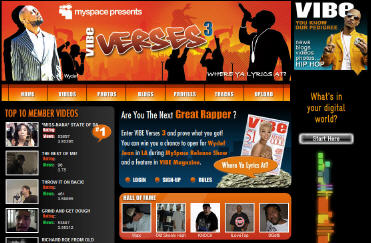
In a nutshell here's how the deal works: a major social networking site (MySpace) has partnered with a specialty publisher (VIBE) for a user generated video-dominated contest (VIBE Verses 3) to build a long term user-generated franchise (powered by KickApps), which will be mainly supported by ad sales.
To understand the deal better, I talked to Michael Chin, SVP of Marketing at KickApps earlier this week. For those not aware, VIBE is a major brand for the urban scene and VIBE Verses 3 is the third round of a contest that "challenges aspiring rap artists to upload videos of themselves performing original lyrics over pre-selected music tracks." Basically you can think of it as an "online-only, urban American Idol." All of the video uploads and social networking is powered by KickApps.
What's interesting to me is that MySpace is involved as the main promotional partner, seeking to build out its strength in this key category. As a large general purpose community site, they're partnering with VIBE, a well-known brand in the category, to bring more value to their members. As Josh Brooks at MySpace puts in the release, "VIBE is a pillar in hip hop and this partnership will help solidify MySpace as the place online for established and developing hip hop artists."
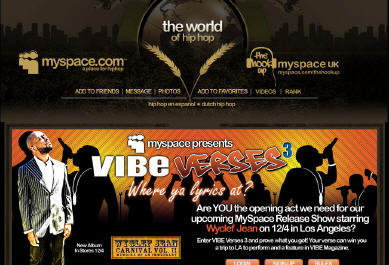
And according to Michael, this was done as a biz dev deal, not an ad sales deal. MySpace and VIBE believe that together they can build a franchise in hip hop that generates longer term value by creating a large, engaged audience of interest to other brands (e.g. Coke, Nike, etc.).
Of course none of this would be possible without broadband - it's the enabler for the user-generated videos that are at the heart of the contest.
In the open broadband video era where direct access to the consumer is ubiquitous, it's going to take more creativity to make deals work for everyone. I think this one is a good example of what can succeed. The deal serves as a template for how other specialty content providers and aggregators/distributors might work together, tapping user participation to build franchises that leverage each party's core skills and assets.
Categories: Aggregators, Brand Marketing, Partnerships, UGC
Topics: KickApps, MySpace, VIBE, VIBE Verses
-
MySpace-VIBE-KickApps Deal May be a Harbinger of What's to Come
Traditional relationships between content providers and powerful aggregators/distributors are being fundamentally challenged broadband video. That's because broadband is an open medium, allowing content providers and brands to enjoy unprecedented direct access to their target audiences. This diminishes a lot of the leverage that aggregators/distributors have traditionally had.
Yet, as I have said for a while, I believe that there's a place for direct-to-consumer and third party distribution/promotion to co-exist harmoniously. But finding good examples has been a challenge. That's why a deal that KickApps announced today with MySpace and VIBE for its "Vibe Verses 3" promotion resonated strongly for me.
In a nutshell here's how the deal works: a major social networking site (MySpace) has partnered with a specialty publisher (VIBE) for a user generated video-dominated contest (VIBE Verses 3) to build a long term user-generated franchise (powered by KickApps), which will be mainly supported by ad sales.
To understand the deal better, I talked to Michael Chin, SVP of Marketing at KickApps earlier this week. For those not aware, VIBE is a major brand for the urban scene and VIBE Verses 3 is the third round of a contest that "challenges aspiring rap artists to upload videos of themselves performing original lyrics over pre-selected music tracks." Basically you can think of it as an "online-only, urban American Idol." All of the video uploads and social networking is powered by KickApps.
What's interesting to me is that MySpace is involved as the main promotional partner, seeking to build out its strength in this key category. As a large general purpose community site, they're partnering with VIBE, a well-known brand in the category, to bring more value to their members. As Josh Brooks at MySpace puts in the release, "VIBE is a pillar in hip hop and this partnership will help solidify MySpace as the place online for established and developing hip hop artists."
And according to Michael, this was done as a biz dev deal, not an ad sales deal. MySpace and VIBE believe that together they can build a franchise in hip hop that generates longer term value by creating a large, engaged audience of interest to other brands (e.g. Coke, Nike, etc.).
Of course none of this would be possible without broadband - it's the enabler for the user-generated videos that are at the heart of the contest.
In the open broadband video era where direct access to the consumer is ubiquitous, it's going to take more creativity to make deals work for everyone. I think this one is a good example of what can succeed. The deal serves as a template for how other specialty content providers and aggregators/distributors might work together, tapping user participation to build franchises that leverage each party's core skills and assets.
Categories: Aggregators, Brand Marketing, Partnerships, UGC
Topics: KickApps, MySpace, VIBE, VIBE Verses
-
Movielink-Target Download Promotion Makes No Sense to Me
Yesterday I received the below email from Movielink promoting a "Steal of a Deal" offer with Target. Here's how it works: I purchase an Ocean's Thirteen DVD at a Target store and I receive a code that then entitles me to download Ocean's Thirteen from Movielink.
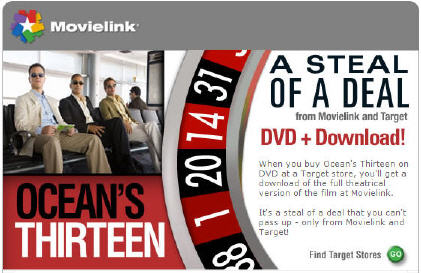
Maybe I'm missing something (and please let me know if I am), but this promotion makes no sense to me and instead seems to possibly undermine the value of the Movielink service.
As with all marketing and promotional efforts, the starting point must always be "What's our objective?" So what is Movielink's objective here?
To expose people to the Movielink brand and service? That wouldn't make sense since I only received the email because I was on their email list in the first place.
To demonstrate there's consumer appetite for downloading the same that was just bought on DVD? That seems like a silly and sort of pointless thing to prove in the first place if you believe the ultimate opportunity for digital downloads is to be a DVD substitute, not a compliment.
To expose people to the breadth of Movielink's service? That's worthy, but the offer is limited to downloading the same title that was purchased, so the user isn't incented to browse and see the full breadth of the Movielink catalog.
Maybe there's another objective, but if so I don't see it. Instead I think the campaign ends up detracting from Movielink by confusing the user and not creating any really new distinctive value. Think about it - if you're a consumer that just bought the Ocean's Thirteen DVD, what new value is the download providing you? (Let me know if you can think of anything, I can't)
Movielink could have enhanced this campaign to greater effect in lots of different ways. Ideas: Open the download choice to anything in the catalog. Or make the download easily giftable to a friend to virally increase Movielink's awareness. Or create a rewards-style program that gives DVD purchasers credits toward subsequent downloads. And so on.
I'm not trying to pick on Movielink's marketers, I see this kind of thing all the time. Murky objectives coupled with confusing/underwhelming offers. For broadband video to succeed - either in paid or ad-supported, marketers must be extremely thoughtful and precise about what they're trying to incent their target audiences to do, and how that specific action helps build the business.
Categories: Brand Marketing, Downloads, Partnerships
-
Showtime Finding Broadband Marketing Groove
The premium cable channel Showtime is coming up with some solid examples of how to creatively use broadband video to promote its programs.
To support Dexter's episode last night, Showtime is developing a parallel story line around the "Dark Defender" with a series of short animated webisodes. Episode 1 is now up at MySpace and Sho.com. Ken Tod, Showtime's VP of Content/Digital Media explained that creating this kind of ancillary content allows the company to target specific audiences more directly. So for example, Dexter has a following among comic/sci-fi fans and Dark Defender has specific appeal to them.
And for Brotherhood, a program set in Providence, Rhode Island, they landed a cardstacker to create the state's capitol building out of 22,000 cards. Posted on YouTube 3 weeks ago, it's generated 350,000+ views.
For Showtime, and for any other premium content providers, broadband's ability to expose potential viewers to their shows is huge. Doing so with novel approaches like the ones above continue to demonstrate how broadband opens up a whole new creative palette for marketing and programming teams. More evidence that traditional marketing equations are changing.
Categories: Brand Marketing, Cable Networks
Topics: MySpace, Showtime, YouTube
-
Bud.TV + New Yorker = ?
Thumbing through the latest version of the New Yorker I noticed the ad shown at right (scanned B&W
 version, a little hard to read online). It's an intriguing invitation to enter something called the "Bud.TV Movies Rock BudTUBE" contest (that's a mouthful). It goes on to ask you to "reinterpret" one of the featured movie scenes on Bud.TV. The winner gets a trip to LA and a possible meeting with producer Stacey Sher.
version, a little hard to read online). It's an intriguing invitation to enter something called the "Bud.TV Movies Rock BudTUBE" contest (that's a mouthful). It goes on to ask you to "reinterpret" one of the featured movie scenes on Bud.TV. The winner gets a trip to LA and a possible meeting with producer Stacey Sher.So I go to Bud.TV to learn more and all I can find is a small icon on the home page that leads to this contest landing page.
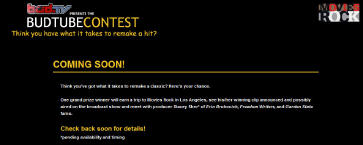
It doesn't say when this contest will launch, doesn't ask me to submit an email address or to sign up to be notified when the contest goes live and doesn't provide any additional teaser information beyond what was in the New Yorker ad (like how about at least showing a few of the featured movie scenes?).
At first I thought the New Yorker magazine, with its liberal-minded, somewhat elitist audience, seemed like an odd place to be marketing a contest sponsored by a beer brand, but maybe there was something I was missing. But now seeing this underwhelming landing page, my conclusion is that this whole Bud.TV contest is a misfire so far. Wouldn't you expect a marketer of Anheuser-Busch's stature to execute the details better than this? I would.
Bud.TV has been widely criticized, but it remains a bold attempt by Bud to use broadband to change the marketing equation and improve engagement with its customers. However, if it's going to be effective, it's going to have to execute far better than it has with this contest. A lesson to all brand marketers experimenting with broadband - try your best to create a cohesive and memorable user experience.
Categories: Brand Marketing, Magazines
Topics: Anheuser-Busch, Bud.TV, New Yorker
-
Brand Marketers Jumping on Broadband Video Bandwagon
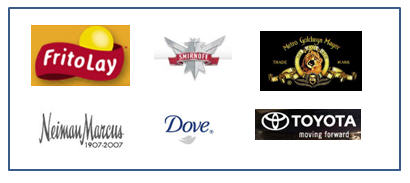
Question: What do Frito-Lay, Unilever, Neiman Marcus, Heinz, Toyota, Smirnoff and MGM have in common?
Answer: In just the last month each of these companies has announced plans to launch some type of broadband video marketing program. Beginning of a trend? You betcha.
Premier brands from one industry to another are recognizing the importance of using video to reach out to and engage better with their customers. Yet I read with interest this piece in yesterday'sWSJ, discussing a big marketers' conference that sold out for the first time ever this year. Adapting to the digital world is a top concern. A Booz Allen survey found that most marketers allocate only 5-10% of their ad budgets to digital media, while online usage continues to soar.
So kudos to the companies mentioned above and the others which are taking their first steps into the broadband world, trying to figure out what tactics work in this new era. Their efforts are varied and reflect the sense of experimentation pervading the market. Consider - Frito, Heinz and MGM are all using some type of content to incent UGC activity. Unilever's Dove soap and Smirnoff are posting original video on YouTube, trying to catch a viral wave. Meanwhile Toyota has devised a new Xbox game called "Yaris" after one of its cars.
As the Super Bowl season approaches, we can expect a lot more broadband video activity from the marketers. Almost 2 years ago I wrote, "The $10 Million Super Bowl Ad". It's worth a peek, I think we're heading in that direction as marketers realize how broadband tie-ins can breathe huge additional life into 30 second Super Bowl spots.
Categories: Brand Marketing, UGC
Topics: Frito-Lay, Heinz, MGM, Neiman Marcus, Smirnoff, Toyota, Unilever
-
MGM's "Lions for Lambs" Google/YouTube Promotion Continues Studios' UGC Efforts
MGM is the latest studio to reach out to fans to help promote one of its films, the upcoming "Lions for Lambs". In a deal with Google/YouTube, the studio is sponsoring a contest in which users can submit a 90 second video on a topic they're passionate about. Entries are being accepted until Oct. 17th and the winner, who will have $25,000 donated to a charity of his/her choice, will be selected on Nov 9th.
This promotion follows the mashup competition Metacafe and Universal conducted this past summer around the studio's "Bourne Ultimatum" release. At the time, I noted that broadband is introducing a whole new element into the film marketing equation, opening up huge opportunities for creativity and fan involvement. As the tools continue to improve I expect we're going to see a lot more of these "UGC-assisted" campaigns.
Studios (and others) are going to continue to experiment with just how much fans are willing to be a part of the marketing machinery. Of course nobody knows, but my guess is that if the incentives are right, the promotions are fun and the stars are compelling, it's going to be a pretty rich vein for film marketers to tap into.
Categories: Brand Marketing, FIlms, Partnerships, UGC
Topics: Google, Lions for Lambs, MGM, YouTube
-
Metacafe’s “Bourne Ultimatum” Mashup Will Spur Imitators
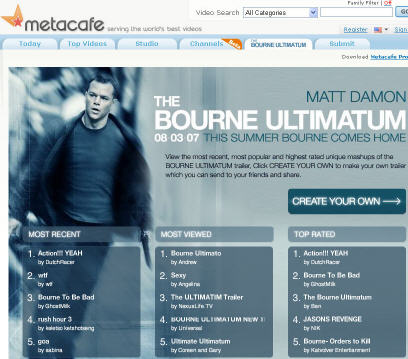
The Metacafe team posted a progress update on its "Bourne Ultimatum" mashup initiative, launched with Universal Pictures on July 23rd. To date, over 1,000 mashups have been posted, with the most popular ones highlighted on the site. Metacafe and Universal teamed up with Diffuse Media Group for the simple-to-use mashup tool.
These kinds of mashups are such a winning idea, it’s amazing to me that they still haven't gained a ton of market momentum. I think it’s just a matter of time, it’s so easy to execute.
Here, Universal provided a collection of scenes and music from the movie. Fans can express their enthusiasm by mixing them up as they please overlaying the music tracks provided. Especially for a franchise like "Bourne", where rabid fans eagerly await each sequel, allowing these folks to participate in the promotional buildup is a real win-win. Tomorrow, when "Bourne" opens everywhere, there will already have been tens (hundreds?) of thousands of people talking up the flick who have seen the mashups or created their own.
Compare this level of fan engagement and promotion to the traditional process of producing 1 trailer and then paying for expensive TV time to promote it. That model seems so yesterday by the standards of what broadband video and Web 2.0 are enabling.
Specifically, broadband is enabling a whole new element of the marketing mix to take root. And the possibilities for where mashups go from here are limitless. Consider: how about letting fans mix in their own voice-overs of certain scenes or mix in their own video clips or have the studio create contests to showcase and reward winning mashups (e.g. Matt Damon-signed, collector’s edition DVD for the winner and such). The list goes on.
I’m expecting lots of smart marketers are going to be increasing their mashup activity quite soon.
Categories: Brand Marketing, FIlms, Partnerships, UGC
Topics: Bourne, MetaCafe, Universal Pictures


